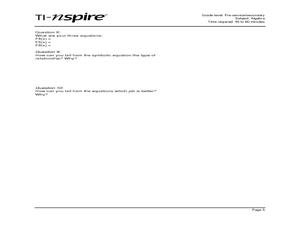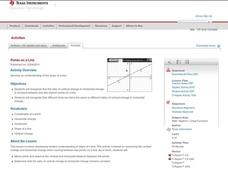Texas Instruments
Areas of Regular Polygons and Circles
Learners explore area of polygons and regular polygons in this math instructional activity. They calculate the area of several polygons using Cabri Jr. and analyze shapes and write formulas to solve for the area.
Curated OER
Exploration of Trigonometry
Learners explore how changing an angle in a triangle changes the ratio of the sides. They also explore how changing the sides can make changes to an angle in a triangle. Finally, they determine how two different pairs of sides, in the...
Texas Instruments
Confectionery Delight
High schoolers explore the problem of maximizing the volume of a box by making a physical model and observing how changes in the orientation of the paper changes the volume. They use the symbolic capacity of their calculators and...
Curated OER
Cabri Jr. Inscribed Angles
Young scholars construct inscribed angles using Cabri Jr. They draw a circle on their graphing calculator, then construct an inscribed angle and measure its angle measures. Learners drag the inscribed angle around the circle. They make...
Curated OER
Angles Formed By Parallel Lines
Young scholars explore the concept of angles formed by parallel lines.They graph two parallel lines cut by a transversal, then measure the angles formed by the transversal and record the data in a table. Learners make conjectures about...
Curated OER
Match Me!
Young learners explore motion graphs in this instructional activity. They investigate distance-time plots as they move in a specific way in front of the CBR in an attempt to make a motion plot that matches a given plot. Pupils explore...
Curated OER
Logarithmic Transformations
Using the TI calculator to visualize and make predictions, high schoolers perform transformation vertically and horizontally on logarithmic graphs in order to solve problems.
Curated OER
AP Calculus Exam Prep
Pupils practice sample questions from the AP Calculus Exam. They solve calculus problems involving bounded regions, integration, derivatives, and limits. They then answer free response and multiple choice questions on the above mentioned...
Curated OER
Exploring Complex Roots
In exploring the concept of complex roots, students find the axis of symmetry and roots of parabolas. Then, they discuss what makes a solution complex and how to identify functions with complex roots.
Curated OER
TI-Nspire Activity: What Does Your Representation Tell You?
By learning to select the best representation for three meal plans, students compare three meal plans to determine the best choice. Data for the meal plans is sorted on a table, as an algebraic equation, and graphed on a coordinate grid....
Curated OER
Nested Similar Triangles
Nested triangles have been created so that they share a common vertex and vertex angle. Learners drag the endpoints of the side that is opposite the common angle to discover the conditions that make the nested triangles similar. When...
Curated OER
Scale Factor Area Perimeter
Mathematicians compare triangles at different scales. In this geometry lesson plan, high schoolers calculate the area and perimeter of triangles. They use the Ti to make observation of the change that takes place as the triangles are...
Curated OER
Area Measures and Right Triangles
Your class will investigate the relationship among different triangles. This geometry lesson, demonstrates how to make a connection between triangles and the Pythagorean Theorem. They identify the missing side or angle of a triangle.
Curated OER
Points on a Line
How do you find slope? You use points on a line of course. slope. Teach your class how to calculate and differentiate between horizontal and vertical lines. They are sure to be pros at graphing lines on a coordinate plane by the end of...
Curated OER
Comparing Linear and Exponential Functions
Teach your class how to differentiate between linear and exponential functions. They use exponential properties to solve problems, graph them using the TI-Navigator, and make comparisons.
Curated OER
Tessellations with Regular Polygons
Show your learners how to create tessellations using different polygons. This is achieved by having young scholars make observations of polygons to find the ones that will tessellate.
Curated OER
Rock On!
Fourth graders make models of igneous, metamorphic, and sedimentary rocks out of different types of candy and cookies.
Curated OER
Polar Graphs
Students graph polar graphs. In this calculus lesson, students convert between polar and rectangular coordinates. They graph their solution on the TI calculator and make observations.
Texas Instruments
Transformational Puppet
High Schoolers create a puppet and make predictions using the TI Navigator. In this math lesson, they will discuss their results as they explore transformation. This assignment requires the TI navigator or a smartboard.
Curated OER
A Little Bit of This.. A Little Bit of That
Students use the order of operations and fraction computations to determine the amount of each ingredient to make No Bake Cookies. In this measuring lesson, students solve the expression to prepare a dessert for lunch. Students prepare...
Curated OER
Estimation
Fourth graders view a variety of rice products and calculate their cost. In this rice math lesson plan, 4th graders estimate cost and multiply to find 8 of each item. Students estimate using different amounts of rice products. Students...
Curated OER
Counting Chart
Elementary learners discover counting through a counting chart. In this math lesson plan, students identify numbers 1-100. They then point or recite their counting numbers.
Curated OER
Applications of Linear Systems
In this Algebra I/Algebra II worksheet, students solve verbal problems whose solution requires the use of a system of linear equations. The five page worksheet contains a combination of thirty-one multiple choice and free response...
Curated OER
Zeros in the Quotient
In this solving quotients in word problems worksheet, students divide three-digit and four-digit numbers by one-digit numbers and conduct multiple steps to problem solve with zeros in the quotients. Students solve six problems.

























